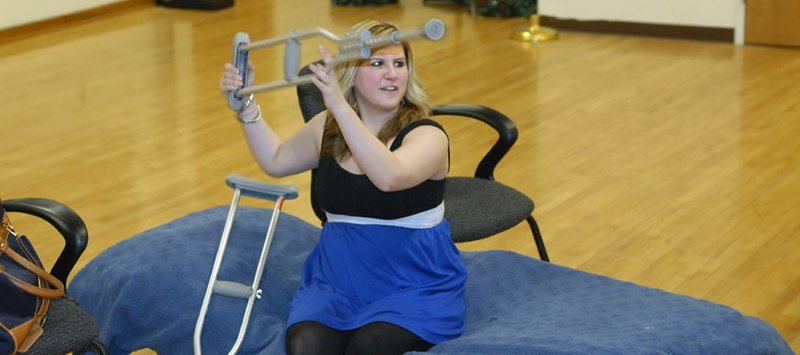
- #BREAK A LEG CRACKED#
- #BREAK A LEG SKIN#
Detailed descriptions of the symptoms and what caused the injury.You may want to write a list that includes: There's a risk of infection around the surgical pins.Įxplore Mayo Clinic studies testing new treatments, interventions and tests as a means to prevent, detect, treat or manage this condition.ĭepending on the severity of the break, your health care provider may recommend examination by an orthopedic surgeon. This device provides stability during the healing process and is usually removed after about 6 to 8 weeks. Some injuries are treated with a metal frame outside the leg attached to the bone with pins.
 A fracture that is the result of a crushing accident. Loose bone fragments that could enter a joint. This type of surgery is more likely in people who have: However, you may need surgery to implant plates, rods or screws to maintain proper position of the bones during healing. Immobilization with a cast or splint heals most broken bones. Rehabilitation can help, but it may take up to several months - or even longer - for complete healing of severe injuries. Because you haven't moved your leg for a while, you may even have stiffness and weakened muscles in uninjured areas. TherapiesĪfter your cast or splint is removed, you'll likely need rehabilitation exercises or physical therapy to reduce stiffness and restore movement in the injured leg. If you're experiencing severe pain, your health care provider might prescribe stronger pain medications. MedicationsĪ pain reliever such as acetaminophen (Tylenol, others) or ibuprofen (Advil, Motrin IB, others), or a combination of the two, can reduce pain and inflammation. You may need to use crutches or a cane to keep weight off the affected leg for at least 6 weeks. A splint or a cast is often used to immobilize the broken bone. Immobilizationįor a broken bone to heal properly, its movement needs to be restricted. A cast is then used once there is less swelling. Some fractures are splinted at first to allow swelling to subside. If you have a displaced fracture, the care team may need to move the pieces of bone back into their proper positions before applying a splint - a process called reduction. Here, health care providers typically evaluate the injury and immobilize the leg with a splint. Treatment for a broken leg usually begins in an emergency room or urgent care clinic. Greenstick fractures are more likely to occur in children because a child's bones are softer and more flexible than those of an adult. In this type of fracture, the bone cracks but doesn't break all the way through - like when you try to break a green stick of wood. A displaced fracture may require surgery to realign the bones properly. In this type of fracture, the bone fragments on each side of the break are not aligned. In complete fractures, the bone has broken into two or more parts.
A fracture that is the result of a crushing accident. Loose bone fragments that could enter a joint. This type of surgery is more likely in people who have: However, you may need surgery to implant plates, rods or screws to maintain proper position of the bones during healing. Immobilization with a cast or splint heals most broken bones. Rehabilitation can help, but it may take up to several months - or even longer - for complete healing of severe injuries. Because you haven't moved your leg for a while, you may even have stiffness and weakened muscles in uninjured areas. TherapiesĪfter your cast or splint is removed, you'll likely need rehabilitation exercises or physical therapy to reduce stiffness and restore movement in the injured leg. If you're experiencing severe pain, your health care provider might prescribe stronger pain medications. MedicationsĪ pain reliever such as acetaminophen (Tylenol, others) or ibuprofen (Advil, Motrin IB, others), or a combination of the two, can reduce pain and inflammation. You may need to use crutches or a cane to keep weight off the affected leg for at least 6 weeks. A splint or a cast is often used to immobilize the broken bone. Immobilizationįor a broken bone to heal properly, its movement needs to be restricted. A cast is then used once there is less swelling. Some fractures are splinted at first to allow swelling to subside. If you have a displaced fracture, the care team may need to move the pieces of bone back into their proper positions before applying a splint - a process called reduction. Here, health care providers typically evaluate the injury and immobilize the leg with a splint. Treatment for a broken leg usually begins in an emergency room or urgent care clinic. Greenstick fractures are more likely to occur in children because a child's bones are softer and more flexible than those of an adult. In this type of fracture, the bone cracks but doesn't break all the way through - like when you try to break a green stick of wood. A displaced fracture may require surgery to realign the bones properly. In this type of fracture, the bone fragments on each side of the break are not aligned. In complete fractures, the bone has broken into two or more parts. #BREAK A LEG CRACKED#
This term means that the bone is cracked but not separated into two parts.

#BREAK A LEG SKIN#
In closed fractures, the surrounding skin remains intact. This is a serious condition that requires immediate treatment to decrease the chance of an infection. In this type of fracture, the skin is pierced by the broken bone. Fractures are classified into one or more of the following categories: Stress fractures may require only rest and immobilization, while other breaks may need surgery for best healing. Treatment of a broken leg will vary, depending on the type and location of the break.






 0 kommentar(er)
0 kommentar(er)
